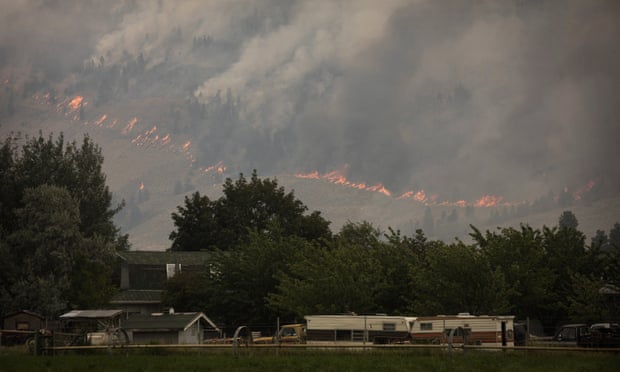
Canada is warming twice as fast as the rest of the world, a landmark government report has found, warning that drastic action is the only way to avoid catastrophic outcomes.
“The science is clear – Canada’s climate is warming more rapidly than the global average, and this level of warming effectively cannot be changed,” Nancy Hamzawi, assistant deputy minister for science and technology at Environment and Climate Change Canada, told reporters on Monday.
How to make a carbon tax popular? Give the proceeds to the people
Read more
The report, released late on Monday by Environment and Climate Change Canada, paints a grim picture of Canada’s future, in which deadly heatwaves and heavy rainstorms become a common occurrence. Forty-three government scientists and academics authored the peer-reviewed report.
While global temperatures have increased 0.8C since 1948, Canada has seen an increase of 1.7C – more than double the global average.
And in the Arctic, the warming is happening at a much faster rate of 2.3C, the report says.
While the increased warming in the Arctic is not yet fully understood, snow and ice play a critical role in reflecting the sun’s radiation and heat. But scientists say the retreat of glaciers and disappearing sea ice both contribute to a feedback loop of warming, which is one of the factors contributing to Canada’s disproportionate temperature increase.
The report suggests the majority of warming felt in Canada and around the globe is the result of burning fossil fuels.
Canada has already pledged to cut emissions by 200m tonnes by 2030 – a cornerstone of Prime Minister Justin Trudeau’s national climate strategy – largely through a federally mandated carbon tax and shuttering coal-fired plants.
Despite the urgency of the report, Canada remains mired in a political battle over climate policy.
Trudeau has pushed for a national carbon pricing strategy, and on Monday the federal government imposed the tax on four provinces that refuse to implement one. Conservative politicians have pledged to remove the tax if they win this fall’s general election, arguing that it is too much of a burden for Canadians.
But under the current plan, households will receive rebate cheques from the federal government to offset any added expenses from the tax – meaning costs to the average consumer are negligible.
The report makes clear that Canada faces markedly different outcomes, depending on the policies it chooses to reduce emissions.
Under a scenario in which global emissions are dramatically reduced, average temperatures will rise only 3C across the country by 2100, including the Arctic region.
But if countries – including Canada – fail to act aggressively, increases of 7-9 degrees are likely, and the Arctic faces the prospect of 11 degrees of warming.
When the ice melts: the catastrophe of vanishing glaciers
Read more
Under the report’s worst-case scenario, the risk of deadly heatwaves increases tenfold bring with it droughts and forest fires. Western Canada has already grappled with two years of record forest fire seasons. The risk of major rain events also doubles, meaning cities will be inundated with catastrophic urban flooding.
Advertisement
Access to critical sources of fresh water will also be constrained, due in large part to reduced winter snowfall, which in turn becomes a source of clean water when the snowpack melts.
Many of the previously documented effects – melting permafrost, disappearing sea ice and glacial retreat – are only set to intensify in the coming years.
“We are already seeing the effects of widespread warming in Canada,” said Elizabeth Bush, a climate science adviser at Environment Canada, told reporters. “It’s clear, the science supports the fact that adapting to climate change is an imperative. Urgent action is needed to reduce emissions.”
Since you’re here…
… we have a small favour to ask. More people are reading and supporting our independent, investigative reporting than ever before. And unlike many news organisations, we have chosen an approach that allows us to keep our journalism accessible to all, regardless of where they live or what they can afford.
The Guardian is editorially independent, meaning we set our own agenda. Our journalism is free from commercial bias and not influenced by billionaire owners, politicians or shareholders. No one edits our editor. No one steers our opinion. This is important as it enables us to give a voice to those less heard, challenge the powerful and hold them to account. It’s what makes us different to so many others in the media, at a time when factual, honest reporting is critical.
Every contribution we receive from readers like you, big or small, goes directly into funding our journalism. This support enables us to keep working as we do – but we must maintain and build on it for every year to come. Support The Guardian from as little as $1 – and it only takes a minute. Thank you.